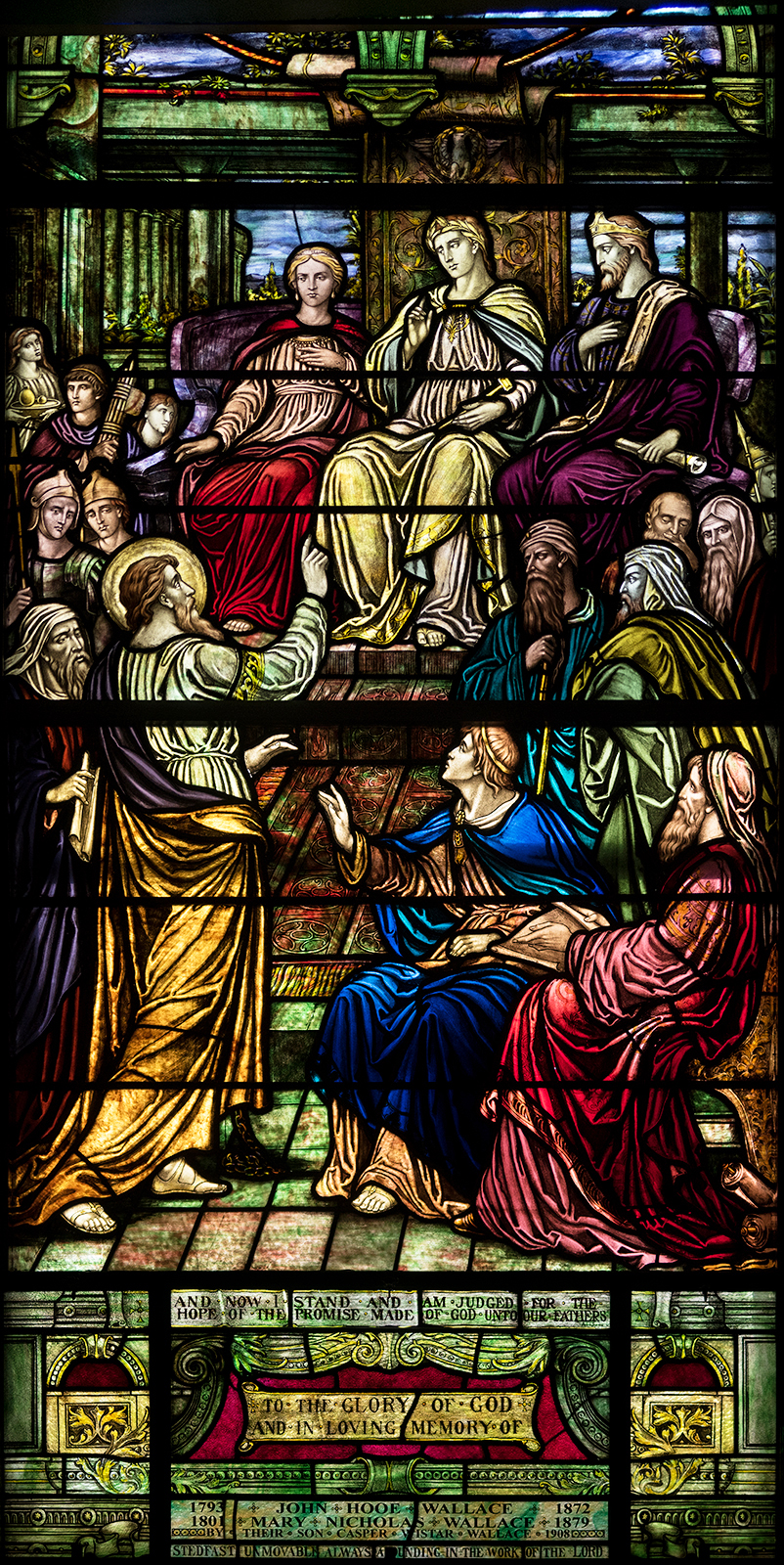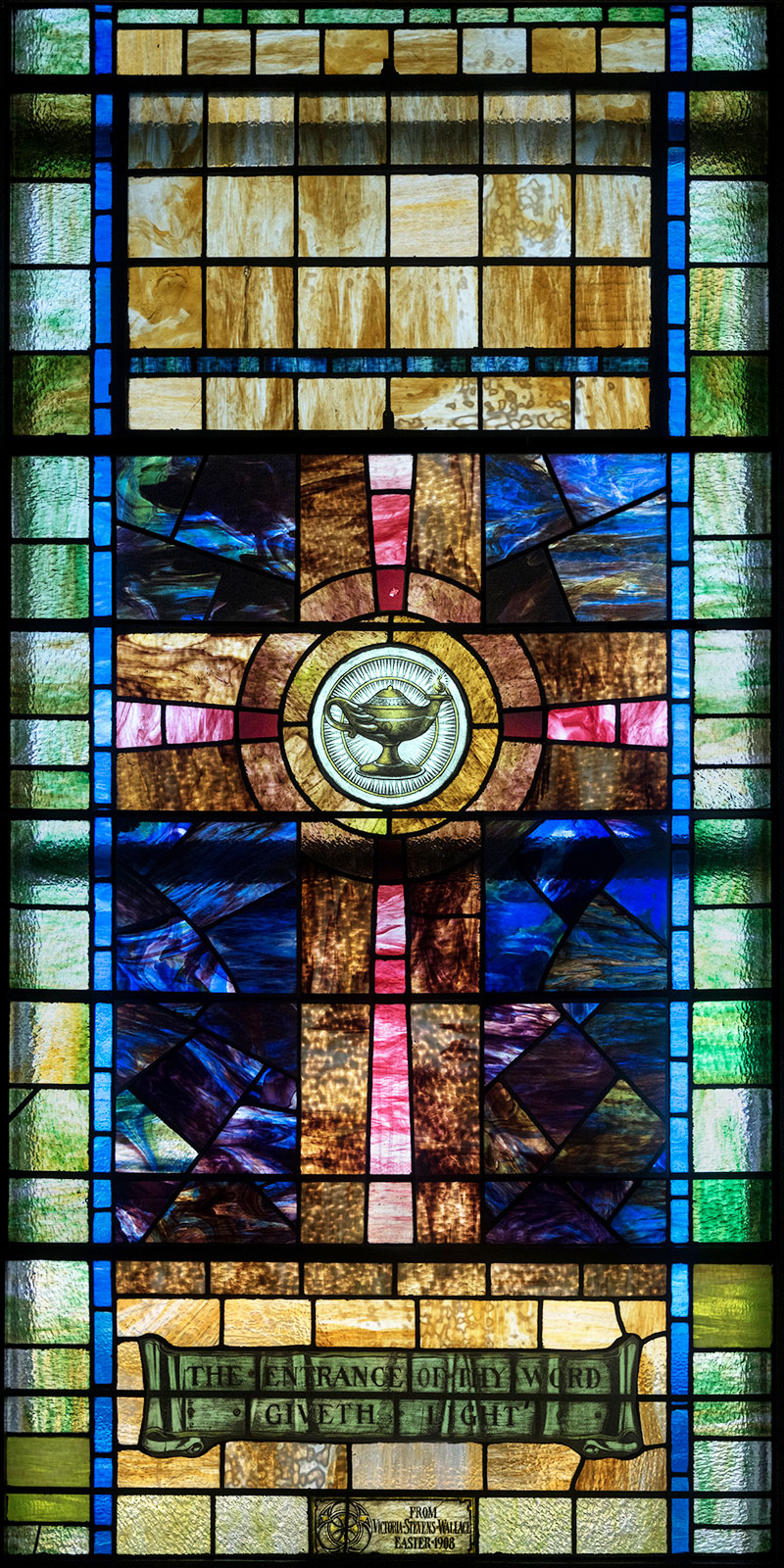
Charles Hogeman was also more of a traditionalist who created several mosaic based windows as well as windows with vivid painting. Most of our windows reflect his work. His life is connected with another Charles, Charles Booth
Charles Booth (b. 1844/d. 1893) was an Englishman who came to the US in 1875, started his glass business in 1880 and whose stained glass window designs beautify a number of churches throughout the United States. He lived in Orange, NJ, Gower Street where he had his workshop in a shed at the rear of his home. His showroom and “office” was in New York City. 47 Lafayette Place in Manhattan, in a building owned by the city’s Episcopal Diocese.
Booth appears to have shared this display space with Charles F. Hogeman, who specialized in ecclesiastical metalwork.
Hogeman represented Booth in NY. In 1876, they published together “Hints on Church and Domestic Windows, Stained and Decorated” (a thinly disguised sales pamphlet?). And from 1880 until Booth’s death, nearly every issue of The Churchman, the monthly magazine of the Episcopal Church, included a small notice for “Charles Booth — Glass Stainer,” an ad space shared with Hogeman.
Booth gained some international attention only after 1986 when the Metropolitan Museum mounted In Pursuit of Beauty: Americans and the Aesthetic Movement. Art historian Alice Cooney Frelinghuysen writes “Booth’s published designs, which consist solely of an outline, are abstract formal patterns of rigidly symmetrical flowers and leaves. In some cases, the original plant shape has been flattened, simplified and formalized until it appears only as halves or quarters.” She notes the “lighter and fresher” tones of his palette and his use of the “sunflower motif.” Booth’s designs may have influenced that of Charles Hogeman with his cross based windows.
Booth died of influenza and pneumonia on December 13, 1893. Hogeman had moved into the house in Orange and continued to operate the business in both Orange and New York City as late as 1912 and Orange NJ until 1930.
1. St. Paul Before Agrippa, 1908
 <
<
Lower Subject: Saint Paul Before Agrippa
Description: Window was reported to be in position by the Daily Star in an article on March 28, 1908
Donor: Wistar Wallace was responsible for this window through his will and for investment in what would become the Wallace Library just across George Street.
Techniques: Paul is rendered larger than the other figures which may indicate both the subject of the window and the fact he had the upper hand. He is the only figure with a halo. The Jewish leaders appear on the right, visibly angry and the Romans on the left with the Roman columns in the background and the Roman Fasces (bundles), a symbol for authority also on the left. The prosecutor Festus appears uneasy on the way the proceedings have been going and Bernice and Agrippa on either side appear to be scowling.
Religious Background – Paul was imprisoned in Caesarea had been proved innocent four different trials or hearings: before the mob, before the Sanhedrin, before Felix, and before Festus but he was still being imprisoned in Caesarea. Paul has not done what he was accused – 1. blaspheming God by desecrating the temple 2. Encouraging people to disobey Mosaic Law 3. Sedition, working as an insurrectionist and creating riots against the government. Both the Jewish and Roman courts attested that he had not done those things.
Who were these people?
- Agrippa was one of the Herods. He was the son of Herod Agrippa 1 who had James beheaded and Peter imprisoned. Herod Agrippa II’s great uncle, Herod Antipas, beheaded John the Baptist. However, Agrippa was a small-time king, small area of Northern Palestine and Galilee. Bernice was Agrippa’s sister
- Festus was the prosecutor of Judea
- Felix was the governor
- Bernice was also the sister of Drusilla, the wife of Felix
So why was Paul retained as a prisoner?
Paul was retained as a prisoner because the Roman governors didn’t have the courage to release him. They knew the Jewish leaders wanted him dead and they were afraid to let Paul go. They wanted him to be condemned and executed. On the basis of Roman justice, Festus couldn’t honor the demand of the Jewish leaders. He didn’t have any accusations
At the beginning of Acts 25, Festus had gone to Jerusalem to meet with the Jewish leaders where they wanted him transferred to Jerusalem. They secretly plotted to kill him Festus instead said he was going to Caeseria and encourage some of them to accompany him there and present the charges.
In the hearing Paul appealed for a decision from the Emperor which a Roman could do and thus go to Rome Once Paul made the appeal, Festus had no choice–he commanded Paul to be retained in Caesarea until he could send him to Rome. But he couldn’t send him because he didn’t know what to tell Rome about him. He couldn’t tell them that Paul was mad, claiming that someone was alive who was really dead. Rome wouldn’t have been interested
A few days later Agrippa and Bernice arrived in Caesarea for a courtesy call for Festus. This was a great opportunity for Festus Festus admitted that the Jewish leaders didn’t have a case and the only issue was “some points of dispute with him about their own religion” and about the resurrection when claimed Christ was still alive He couldn’t send Paul to Rome without an accusation, so he turned his problem over to Agrippa. They had to find an accusation
The stained glass window depicts the hearing.
Besides the above and chief captains, and principal men of the city as well as Jewish leaders Paul was not very imposing physically. With all the glitter in the auditorium, in walks a little bandy-legged, baldheaded, Jewish man He was shackled by a chain as he stood in the middle of the auditorium. Festus is in the middle with King Agrippa and Bernice on either side
As the Daily Star writes about the window “The subject of the picture is the argument of Paul on the resurrection of the dead, Acts Chapters 25 and 26. The picture itself represents Paul in chains before Festus, with King Agrippa and Bernice on either side. Paul’s accusers, guards, chief priests, and people around, with the quotation beneath his speech “And now I stand and am judged for the hope of the promise made of God unto our fathers.”
Since this was more of a hearing, Paul didn’t have to be there. He was there was another platform for him to preach Christ. He turned everything that ever happened to him into an opportunity to preach Christ. He had been waiting two years to say something, and now he had his opportunity
Paul reviews his conversion on the road to Damascus. “I preached that they should repent and turn to God and prove their repentance by their deeds.” am saying nothing beyond what the prophets and Moses said would happen—that the Christ would suffer and, as the first to rise from the dead, would proclaim light to his own people and to the Gentiles.”
Festus responded that he thought Paul was out of his mind. He couldn’t understand why the Jewish leaders would bother with him. But Festus didn’t understand the implications of the resurrection because he didn’t understand the implications of the Messiah.
When Paul ended his testimony in Acts 26:28, Agrippa said, “Are you trying to convert me?” That’s exactly what Paul was trying to do, and not only Agrippa but everyone else as well.
Paul replied, “Short time or long—I pray God that not only you but all who are listening to me today may become what I am, except for these chains.”
The king rose and with him the governor and Bernice and those sitting with them. They left the room, and while talking with one another, they said, “This man is not doing anything that deserves death or imprisonment.” Agrippa said to Festus, “This man could have been set free if he had not appealed to Caesar.
2. Cross Windows 1908

Hogeman created a series of windows similar in design for the lower part of the Nave for windows given by the Wallace family.
The Wallace windows use similar glass around a center symbols arranged in five rows of stone with the central theme in the middle. Surrounding the symbol are two concentric circles of stones. Within each row are different shapes of glass. The effect is traditional without any special treatment of the glass or painting.
In this set are the following:
Cross with Alpha and Omega
Cross with Chi Rho
Cross with Crown
Cross, Dove with Olive Branch
Cross with Dove
Font- Be Born Of Water And Of The Spirit
Praying Hands
Cross with Lamp
Moon and Stars
Cross with Sun
Cross with Thurible